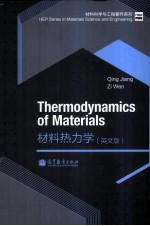

材料热力学 英文版PDF电子书下载
- 电子书积分:11 积分如何计算积分?
- 作 者:蒋青,文子著
- 出 版 社:北京:高等教育出版社
- 出版年份:2011
- ISBN:9787040296105
- 页数:298 页
Chapter 1 Fundamentals of Thermodynamics 1
1.1 Thermodynamics of Materials Science,Scope and Special Features of the Book 1
1.2 Concepts of Thermodynamics 5
1.3 Temperature and Zeroth Law of Thermodynamics 10
1.4 First Law of Thermodynamics 11
1.5 Entropy and Second Law of Thermodynamics 20
1.6 General Thermodynamic Relationships 24
1.7 Third Law of Thermodynamics 32
References 34
Chapter 2 Statistical Thermodynamics 37
2.1 Basic Concepts 38
2.2 Classical Statistic Thermodynamics of Independent Particles 43
2.3 Energy Mode and Energy Levels 47
2.4 Bose-Einstein and Fermi-Dirac Statistics 52
2.5 Application of Quantum Statistics 54
2.5.1 Spatial Configuration of Long Chain Polymers 54
2.5.2 Statistical Thermodynamics of a Paramagnetic Crystal 58
2.5.3 Negative Temperature 63
References 65
Chapter 3 Heat Capacity,Entropy,and Nanothermodynamics 67
3.1 Heat Capacity 67
3.1.1 Relations of Principal Heat Capacities 67
3.1.2 Magnetic Heat Capacity 69
3.1.3 Heat Capacity of Lattice Vibration of Solids 71
3.1.4 Electronic Heat Capacity of Metals 75
3.2 Entropy 78
3.2.1 Positional Part of Melting Entropy and Its Evaluation 83
3.2.2 Contribution of Vibrational Part of Melting Entropy of Semiconductors 85
3.2.3 Electronic Component of Melting Entropy 87
3.3 Nanothermodynamics 93
3.4 Melting Thermodynamics 95
3.4.1 A Melting Criterion 95
3.4.2 Existing Models for Size-dependent Melting of Crystals 96
3.4.3 Size-dependent Melting Thermodynamics of Crystals 100
3.5 Cohesive Energy 106
3.5.1 Size-dependent Cohesive Energy of Crystals 106
3.5.2 Vacancy Formation Energy and Cohesive Energy of Clusters 108
3.6 Size Effect on Bandgap of Ⅱ-Ⅵ Semiconductor Nanocrystals 114
References 116
Chapter 4 Phase Diagrams 119
4.1 Gibbs Phase Rule and Phase Diagram of Unary System 119
4.2 Clapeyron Equation in Condensed State Equilibria 121
4.3 Solution,Partial Molar Properties and Chemical Potential 126
4.4 Graphical Representation,Ideal and Regular Solutions 129
4.5 Equilibrium Conditions of Phases and Phase Diagram of Binary Systems 135
4.5.1 Complete Miscibility,Continuous Binary Solution Phase Diagram and Related Size Dependence 136
4.5.2 Immiscibility-Two Mechanisms of Phase Transitions 140
4.6 On Approximation of Gibbs Free Energy Change of Crystallization 144
4.7 Bandgap Energy of Binary Nanosemiconductor Alloys 148
References 154
Chapter 5 Thermodynamics of Phase Transitions 157
5.1 Thermodynamic Classification of Phase Transitions 157
5.2 Landau and Ising Models for the Second-order Phase Transitions 160
5.2.1 Landau Model 160
5.2.2 Ising Model and its Applications 162
5.2.3 Critical Exponent 164
5.3 Thermodynamics of Martensitic and Bainite Transitions 166
5.4 Glass Transition 174
5.4.1 Freezing into Solid State:Glass Formation versus Crystallization 174
5.4.2 Characteristic Properties of Glass Transition 178
5.4.3 Size Effect on Glass Transition 180
5.5 Ferromagnetic and Antiferromagnetic Phase Transitions of Nanocrystals 184
5.5.1 Size-dependent Ordering Temperatures of Ferromagnetic and Antiferromagnetic Nanocrystals 184
5.5.2 Thermal Stability in Exchange-biased FM/AFM Bilayers 191
5.5.3 Ferroelectric Phase Transition of Nanocrystals 197
5.5.4 Superconductive Phase Transition of Nanocrystals 202
References 205
Chapter 6 Thermodynamics of Interfaces 207
6.1 Point Defect Thermodynamics 208
6.2 Line Defects Thermodynamics 211
6.3 Thermodynamics of Interfaces 214
6.3.1 Thermodynamic Description of Surface Free Energy of Liquids and Solids 215
6.3.2 Thermodynamics of Surface Stress and Intrinsic Stress 216
6.3.3 Real Surface:Reconstruction and Relaxation 221
6.3.4 Equilibrium of Fluid Droplets and Solid Particles 225
6.3.5 Wulff Construction and Adsorption on Solid Surfaces 229
6.4 Solid-liquid Interface Energy 232
6.4.1 Bulk Solid-liquid Interface Energy and That at Melting Points 232
6.4.2 Size Dependence of Solid-liquid Interface Energy 239
6.4.3 Nucleus-liquid Interface Energy 242
6.5 Solid-solid Interface Energy 246
6.6 Solid-vapor Interface Energy or Surface Energy 248
6.6.1 Bulk Surface Energy of Elementary Solids 248
6.6.2 γsv0 of Several Ceramics with NaCl Structure 257
6.6.3 Size-dependent Surface Energy of Solids 261
6.7 Liquid-vapor Interface Energy or Surface Tension 264
6.7.1 Bulk Surface Tension and Its Temperature Coefficient 264
6.7.2 Determination of γLv0(Tm) and γ'Lv0(Tm) Values and γLv0(T) and γ'Lv0(T) Functions 267
6.7.3 Size Dependence of Liquid-vapor Interface Energy 275
6.8 Applications of Size-dependent Interface Energy 278
6.8.1 Thermodynamic Phase Stability of Nanocarbons 278
6.8.2 Static Hysteresis of Solid Transition of CdSe Nanocrystals 284
6.8.3 Critical Layer Number and Critical Misfit of Epitaxial Grown Metallic Thin Films 287
6.8.4 Reconstruction Possibility of fcc Metallic Surfaces at Room Temperature 291
References 293
Index 295
- 《流体力学》张扬军,彭杰,诸葛伟林编著 2019
- 《工程静力学》王科盛主编 2019
- 《卓有成效的管理者 中英文双语版》(美)彼得·德鲁克许是祥译;那国毅审校 2019
- 《材料导论》张会主编 2019
- 《空气动力学 7 飘浮的秘密》(加)克里斯·费里著 2019
- 《AutoCAD 2018自学视频教程 标准版 中文版》CAD/CAM/CAE技术联盟 2019
- 《跟孩子一起看图学英文》张紫颖著 2019
- 《AutoCAD机械设计实例精解 2019中文版》北京兆迪科技有限公司编著 2019
- 《材料力学 上》杨在林,杨丽红主编 2011
- 《NiFe2O4基惰性阳极材料的烧结行为及应用性能》杜金晶,王斌著 2019
- 《全国高等中医药行业“十三五”创新教材 中医药学概论》翟华强 2019
- 《培智学校义务教育实验教科书教师教学用书 生活适应 二年级 上》人民教育出版社,课程教材研究所,特殊教育课程教材研究中心编著 2019
- 《指向核心素养 北京十一学校名师教学设计 英语 七年级 上 配人教版》周志英总主编 2019
- 《习近平总书记教育重要论述讲义》本书编写组 2020
- 《办好人民满意的教育 全国教育满意度调查报告》(中国)中国教育科学研究院 2019
- 《高等数学试题与详解》西安电子科技大学高等数学教学团队 2019
- 《北京生态环境保护》《北京环境保护丛书》编委会编著 2018
- 《教育学考研应试宝典》徐影主编 2019
- 《语文教育教学实践探索》陈德收 2018
- 《家庭音乐素养教育》刘畅 2018
